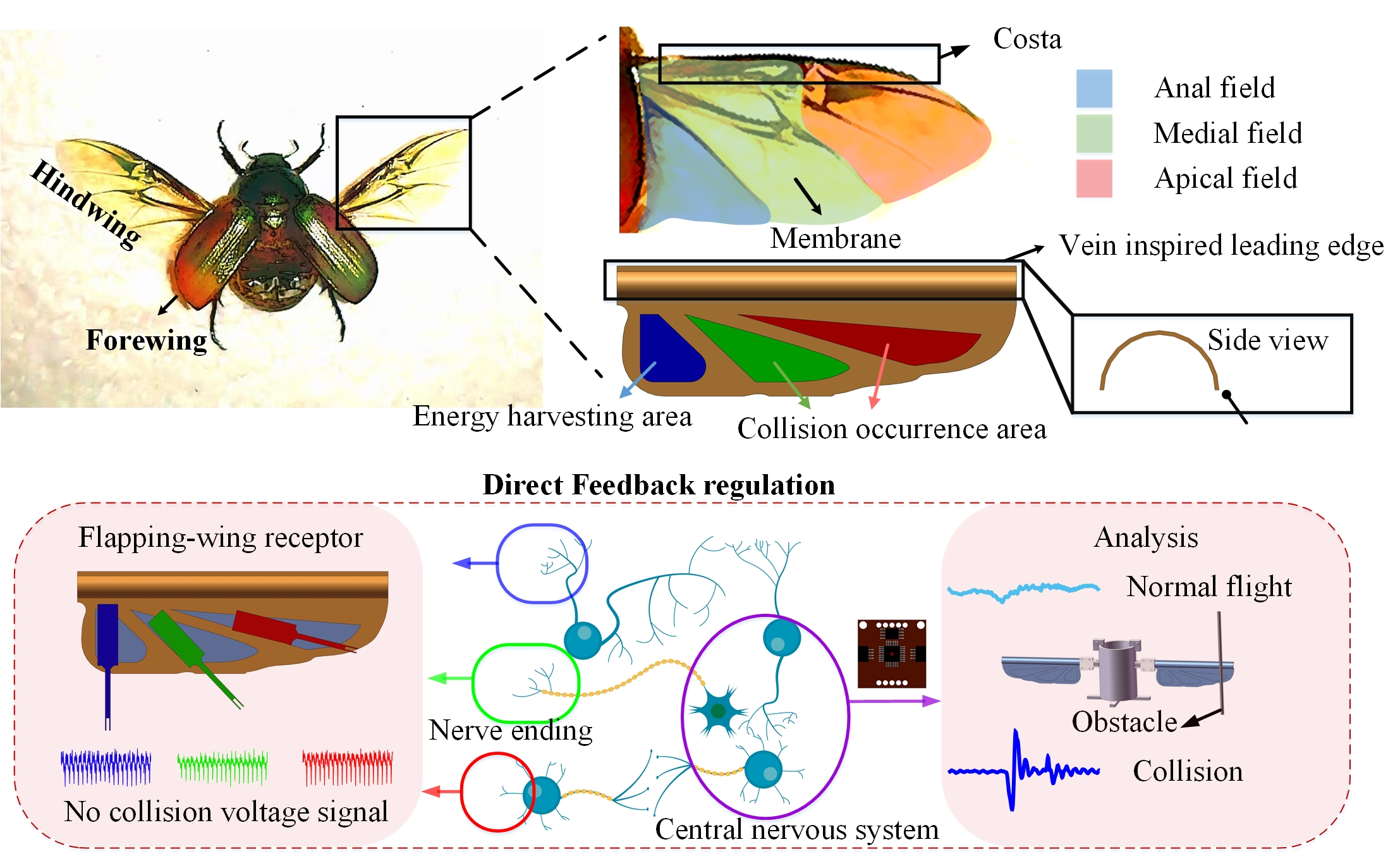Research Progress | The Research Group from the School of Ocean and Civil Engineering Has Proposed A Membranous-wing Robot with Flapping Piezo-mechanoreception
Date:2023-12-11 Reading: 864
Recently, Associate Professor Zhimiao Yan from the Department of Mechanics published the latest research findings in the comprehensive journal 《Advanced Functional Materials》 (Scarab Beetle-Inspired Embodied-Energy Membranous-Wing Robot with Flapping-Collision Piezo-Mechanoreception and Mobile Environmental Monitoring, 2023, 2303745). The first author of this work is Kaiyu Hou, a master's student in the Department of Mechanics. Based on the embodied energy design paradigm, this study developed a multifunctional bionic beetle-inspired membranous-wing robot. Beyond achieving outstanding aerodynamic characteristics, the robot incorporates sensing and energy harvesting capabilities, presenting a novel approach for the design of future intelligent flapping-wing micro air vehicles.
Bio-inspired flapping-wing aircraft hold significant promise in a range of applications, including search and rescue missions, military reconnaissance, and environmental monitoring. Their appeal lies in their compact size, exceptional maneuverability, and versatile operational capabilities, making them a focal point in the evolution of future micro-aircraft. Moreover, insects exhibit remarkable flight characteristics, including rapid banked turns, somersault, hovering, passive angle of attack adjustments, collision recovery maneuvers, and wing folding capabilities. These findings provide valuable insights for the design of bio-inspired aircraft with analogous flight capabilities.
To attain the elevated standards of aerobatics previously mentioned, a harmonious collaboration between an insect's afferent nervous system and motor nervous system is paramount. In contemporary design of flapping-wing aircraft, a suite of onboard sensors shoulder the sensory responsibilities akin to an afferent nervous system, adapting to the diverse demands of various missions. While this approach is straightforward, it amplifies the aircraft's overall weight and poses a challenge to the system's energy supply capabilities. This study integrates smart materials with membranous-wing, proposing a lightweight intelligent membrane-wing that encompasses various functions such as aerodynamic load-bearing, flight collision piezo-mechanoreception, and energy harvesting.
This wing replicates the beetle's semi-tubular costa structure, featuring a compliant leading edge for upstroke aerodynamic load resistance. Inspired by beetle hindwing veins and membranes, the bionic wing with three membranous fields (anal, medial, and apical), using heat lamination of multi-layer materials is fabricated. As a piezo-mechanoreception receptor for micro air vehicles, the bionic intelligent wing senses flapping frequency, wing deformations, and collisions through voltage signals from piezoelectric materials in the three membranous fields. This allows for adjustments to the orientation of the aircraft, as illustrated in Figure 1.

Figure 1. Bionic Design and Neural Sensing
The aerodynamic performance of the bionic wing closely resembles that of a real beetle hindwing. Real flight tests, including ascent, stable flight, descent, landing, and somersault maneuvers, have been performed as shown in Figure 2. Relative to the aircraft's weight, effective lift could offset its weight at most frequencies, with the expanded wingspan enabling flight at lower frequencies. Simultaneously, the embodied energy harvested from the outside during flight can be effectively applied to sensors, such as light intensity and ultraviolet sensors, which are utilized for mobile environmental monitoring and indirect feedback regulation in potential applications such as chemical mapping and pollution detection. In terms of noise reduction, the taut wing membrane can produce less flapping noise than the membranous-wings of traditional flapping wing aircraft. In addition, there are more microstructures and unique flow control technologies reflected in the flight noise reduction of insects or birds in nature, which can provide inspiration for the noise reduction design of flapping wing aircraft.

Figure 2. Aerodynamic Performance Demonstration and Energy Supply Application Scenarios
In future research, intelligent computation will be employed to correlate the voltage signals of the intelligent membranous wing with the actual beetle movement under the same movement conditions. Through neural network reconstruction, the intelligent wing, serving as perceptual intelligence in intelligent computation, imitating the perception ability of actual insects, achieves proprioceptive of angles of attack, wind speeds, and various flight postures.
Paper link:
https://onlinelibrary.wiley.com/doi/10.1002/adfm.202303745




